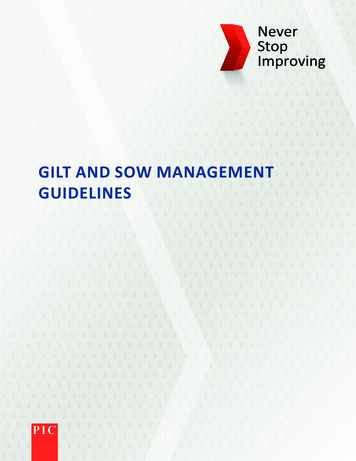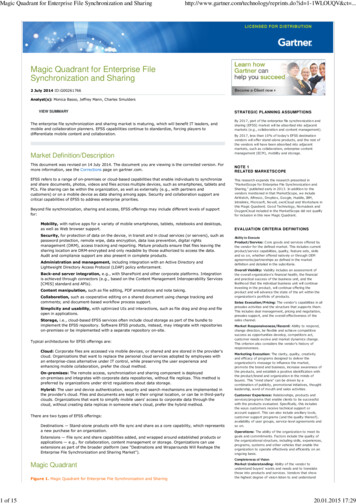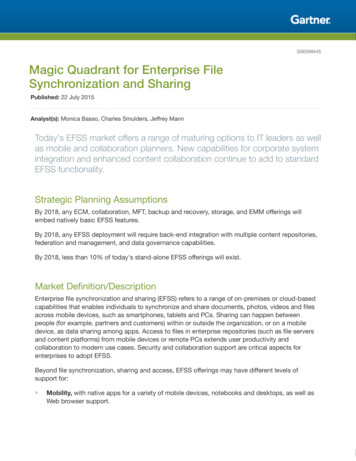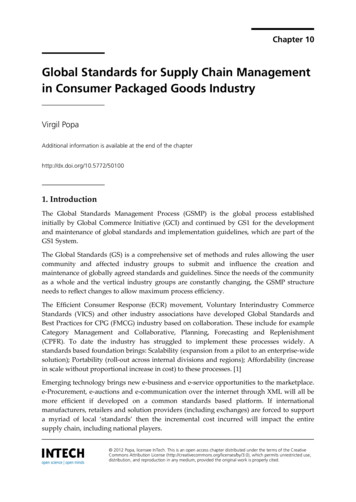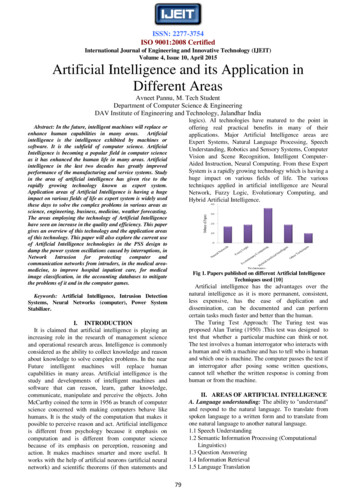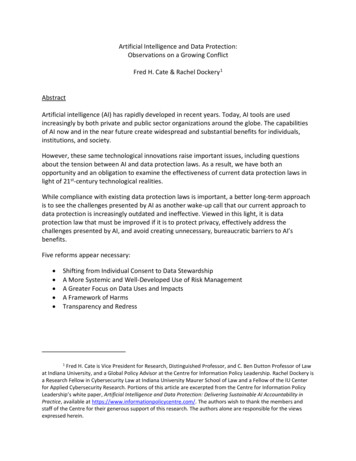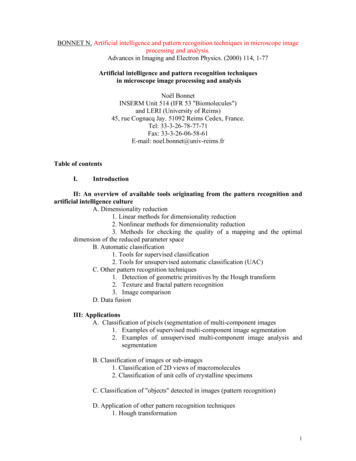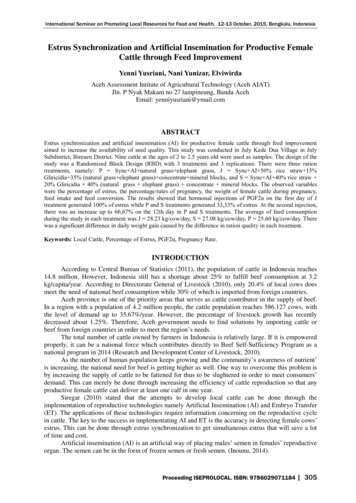
Transcription
International Seminar on Promoting Local Resources for Food and Health, 12-13 October, 2015, Bengkulu, IndonesiaEstrus Synchronization and Artificial Insemination for Productive FemaleCattle through Feed ImprovementYenni Yusriani, Nani Yunizar, ElviwirdaAceh Assessment Intitute of Agricultural Technology (Aceh AIAT)Jln. P Nyak Makam no 27 lampineung, Banda AcehEmail: yenniyusriani@ymail.comABSTRACTEstrus synchronization and artificial insemination (AI) for productive female cattle through feed improvementaimed to increase the availability of seed quality. This study was conducted in July Kede Dua Village in JulySubdistrict, Bireuen District. Nine cattle at the ages of 2 to 2.5 years old were used as samples. The design of thestudy was a Randomized Block Design (RBD) with 3 treatments and 3 replications. There were three rationtreatments, namely: P Sync AI natural grass elephant grass, J Sync AI 50% rice straw 15%Gliricidia 35% (natural grass elephant grass) concentrate mineral blocks, and S Sync AI 40% rice straw 20% Gliricidia 40% (natural grass elephant grass) concentrate mineral blocks. The observed variableswere the percentage of estrus, the percentage/rates of pregnancy, the weight of female cattle during pregnancy,feed intake and feed conversion. The results showed that hormonal injections of PGF2α on the first day of Jtreatment generated 100% of estrus while P and S treatments generated 33,33% of estrus. At the second injection,there was an increase up to 66,67% on the 12th day in P and S treatments. The average of feed consumptionduring the study in each treatment was J 28.23 kg/cow/day, S 27.08 kg/cow/day, P 25.60 kg/cow/day. Therewas a significant difference in daily weight gain caused by the difference in ration quality in each treatment.Keywords: Local Cattle, Percentage of Estrus, PGF2α, Pregnancy Rate.INTRODUCTIONAccording to Central Bureau of Statistics (2011), the population of cattle in Indonesia reaches14.8 million. However, Indonesia still has a shortage about 25% to fulfill beef consumption at 3.2kg/capita/year. According to Directorate General of Livestock (2010), only 20.4% of local cows doesmeet the need of national beef consumption while 30% of which is imported from foreign countries.Aceh province is one of the priority areas that serves as cattle contributor in the supply of beef.In a region with a population of 4.2 million people, the cattle population reaches 586.127 cows, withthe level of demand up to 35.67%/year. However, the percentage of livestock growth has recentlydecreased about 1.25%. Therefore, Aceh government needs to find solutions by importing cattle orbeef from foreign countries in order to meet the region‘s needs.The total number of cattle owned by farmers in Indonesia is relatively large. If it is empoweredproperly, it can be a national force which contributes directly to Beef Self-Sufficiency Program as anational program in 2014 (Research and Development Center of Livestock, 2010).As the number of human population keeps growing and the community‘s awareness of nutrient‘is increasing, the national need for beef is getting higher as well. One way to overcome this problem isby increasing the supply of cattle to be fattened for thus to be slughtered in order to meet consumers‘demand. This can merely be done through increasing the efficiency of cattle reproduction so that anyproductive female cattle can deliver at least one calf in one year.Siregar (2010) stated that the attempts to develop local cattle can be done through theimplementation of reproductive technologies namely Artificial Insemination (AI) and Embryo Transfer(ET). The applications of these technologies require information concerning on the reproductive cyclein cattle. The key to the success in implementating AI and ET is the accuracy in detecting female cows‘estrus. This can be done through estrus synchronization to get simultaneous estrus that will save a lotof time and cost.Artificial insemination (AI) is an artificial way of placing males‘ semen in females‘ reproductiveorgan. The semen can be in the form of frozen semen or fresh semen. (Inounu, 2014).Proceeding ISEPROLOCAL. ISBN: 9786029071184 305
International Seminar on Promoting Local Resources for Food and Health, 12-13 October, 2015, Bengkulu, IndonesiaThere are several methods in performing AI. One of them is by diluting a single male cow‘ssemen for many females. Another one is by performing cross-breeding with males from areas whichhave different climate, as well as for cryopreservation (Thomassen & Farstad, 2009). Each method hasdifferent level of success because its applications have different level of difficulty.Several major factors that play crucial roles in the success of Artificial Insemination (AI) are thequality of frozen semen, the state of females as AI acceptors, the accuracy of AI and the skill ofinseminator.Similarly, it is very important to be aware of the feed intake as it has profound effect on theweight of cattle. Despite of high genetic potential, high percentage in cattle production will not beachieved if the feeding does not meet the nutritional requirements in both quantity and quality.According to Bamualim (2011), the strategy for the success in cattle business requires appropriatetechnology, the empowerment of the management, and the aspect of breeding cattle. However, themost important factor in improving cattle weight gain realistically is by providing feed intake which isconsistent both in quantity and quality. Furthermore, the problem of feed insufficiency due to limitedland must be solved together in order to get a solution (Murgueitioa et al., 2011; Janzen, 2011;Ukanwoko and Igwe, 2012).Giving fodder to cattle often leads them to consume more (Sari, 2010). This is due to the level oftheir palatability; the more frequent fodder is given, the higher cattle palatability gets as they prefernew and fresh forage instead of dry and old one.Beside feed improvement, estrus synchronization and artificial insemination are also performedto improve the productivity of female cattle. Estrus synchronization aims to manipulate the estrus cyclein order to generate simultaneous estrus and ovulation thus improving the efficiency in the use ofartificial insemination (AI) as well as to obtain an increase in pregnancy rate and in the birth of the calf.MATERIALS AND METHODSThis study was conducted from February to December 2013 in Bireuen on Paya Sakti LivestockGroup which preserved productive female cattle. This group consisted of 20 people with a total cattlepopulation of 58.Materials used in this study were rice straw, natural grass, elephant grass, Gliricidia, rice bran,coconut cake, sago, mineral blocks, herbs, Reprodine hormones and frozen semen.Nine productive female cows at the ages of 2 to 2.5 years old were used as samples. The design used aRandomized Block Design (RBD) with 3 treatments and 3 replications as follows;P Sync AI natural grass elephant grass;J Sync AI 50% rice straw 15% Gliricidia 35% (natural grass elephant grass) concentrate mineral blocks;S Sync AI 40% rice straw 20% Gliricidia 40% (natural grass elephant grass) concentrate mineral blocks.The measured variables were the percentage of estrus, the percentage of pregnancy, the weightof the females during pregnancy, feed intake and feed conversion.Estrus percentage was calculated by using the following formula:% Estrus Response (Number of cows in estrus/ Number of tested cows) X100 %The collected data was analyzed by analysis of variance followed by Duncan's multiple rangetest (Steel and Torrie, 1993).RESULT AND DISCUSSIONIdentification of Location for the StudyKeude Dua July is one of the villages located in July subdistrict, Bireuen district, with an area of207 hectares and distance of 3.5 Km to the capital of subdistrict and 5.5 Km to the capital of district. Itis accessible because of the availability of transportation and communication system. This village306 Proceeding ISEPROLOCAL. ISBN: 9786029071184
International Seminar on Promoting Local Resources for Food and Health, 12-13 October, 2015, Bengkulu, Indonesiashares land borders with Meunasah Teungoh, Blang Keutumb, Bate Raya, Peuraden and SeunebokGunci.Artificial Insemination (AI)Adult females which are ready to breed naturally or artificially must be at the age of 32 monthsold because it is the appropriate age to conduct the inclusion. After they start showing estrus signs, theywill be ready for the insemination. The most important factor in performing AI is female fertility.Generally, female fertility occurs at the time of ovulation, which is 18 hours after estrus signs.Ovulation usually takes place after the end of estrus period which is indicated by continous and thickcervical mucus from the vulva of the females. The right time to do the insemination process is usually8 to 9 hours after estrus because the cervix starts to widely open.The artificial insemination in Paya Sakti Group was done to avoid the females in the state ofestrus again. In this case, all the inseminated females were observed and not released into the group inorder to keep them to not be in estrus again which might cause cervical mucus along with injectedspermatozoa to come out again. The insemination can be done after 9 to 18 hours after the signs ofestrus but it will probably experience a little difficulty because the cervix begins to close. After 18hours, it will completely be closed which makes the gun impenetrable.The calculation of S/C is the ratio of the amount of straw used for AI with the total number ofthe inseminated females that become pregnant. In this study, the pregnancy pecentage of cows beingkept intensively in a pen reached 100%. AI is usually conducted by the inseminator at different timesfrom day to night which causes estrus to rise at different times as well but still in the same day. Thesuccess of AI for cattle which are kept in a pen all day long may reach above 80% because theobservation of estrus can be controlled entirely from day to night, whereas the success of AI for thosekept in a pen only at night (individual maintenance) only reaches 32%. This is due to the inaccurateestrus detection because it cannot be controlled completely which makes the implementation of AI isnot timely.In this study, the inseminator performing AI was from the nearest Paya Sakti village, and thestraw used was from the Livestock Department of Aceh province with Bali-cow type. AI was done in 2stages. The first stage was done after 9 hours of estrus as a result of PGF2α hormonal injection and thesecond was 11 days later after the injection of PGF2α.Percentage of EstrusEstrus synchronization is an attempt to make a herd of female cattle be in the state of estrussimultaneously, which is by manipulating the processes of reproduction. It has several advantages asfollows:1. Saving a lot of time as cattle are in the state of estrus in the predetermined scheduled.2. Providing convenient time to conduct artificial insemination, especially on a herd of cattle bytreating them in groups, in relation to the current procedure at the time of ovulation in order tocarry out insemination based on a predetermined schedule.3. Allowing farmers to feed cattle in a homogenous group, especially when it involves the changes inthe consumed ration adjusting to the phases of females‘ pregnancy.4. As a continuation of the simultaneous breeding.5. Limiting the overall period of births on a herd of cattle.6. Enabling birth control with the aim of reducing the mortality of newborn and care arrangements ofthe calf on the other parents.7. Allowing to perform weaning, fattening, marketing cattle and facilitating the use of embryotransfer after mating control is successfully carried out.The application of PGF2α intramuscularly must be carried out directly in the field with a dose of2 ml/cow to the target organ CL. This is applied to the whole group of cattle so that they will be in thestate of estrus simultaneously. After PGF2α hormonal injection, in one or three days, the injectedfemales will show the signs of estrus such as acting nervous, trying to climb the other cows, raisingtails, kissing the back of the other cows, red swollen vulva, producing cervical mucus, approaching themales, being passive when climbed up by males and having a decrease in appetite. Estrussynchronization on two ruminants with different size of body (scale 1-5) showed different resultswhich confirms that small and thin females have lower response than those with medium body size(Vatankhah et al., 2012 )Proceeding ISEPROLOCAL. ISBN: 9786029071184 307
International Seminar on Promoting Local Resources for Food and Health, 12-13 October, 2015, Bengkulu, IndonesiaThe highest percentage of AI success is obtained in 6-9 hours after the rise of estrus. Estrusobservation accuracy will determine the insemination time accuracy. This was proven in this study thatthe percentage of estrus response 3 days later after estrus synchronization were different (see Table 1).The results of hormonal injections (PGF2α) on the first day of all 9 cows were visible in thetreatment of J (Sync AI 50% rice straw 15% Gliricidia 35% (natural turf grass elephantgrass) concentrate mineral blocks). The first injection caused estrus to rise up to 100% while in thetreatment of P and S, the rise was only 33.33%. However, the second injection on day 12 of thetreatment P and S increased the percentage up to 66.67%.Table 1. The percentage of productive females after the first and second PGF2α injectionsFemales in EstrusFirst InjectionSecond InjectionTreatmentsNumberof PercentageNumberofPercentage 266,67Note: J Sync AI 50% rice straw 15% Gliricidia 35% (natural grass elephant grass) concentrate mineral blocks, P Sync AI natural grass, S Sync AI 40% rice straw 20% Gliricidia 40% (naturalgrass elephant grass) concentrate mineral blocksNumberofFemalesOn the first PGF2α injection, the females which were initially not in the state of estrus were inthe follicular phase where follicle developed by the rise in estrogen. On the second PGF2α injection, allcattle (100%) showed the signs of estrus in two days after injection. This was due to all females were inthe luteal phase where the corpus luteum began to function. The second injection was repeated at theinterval of 11 days after the first one with the expectation that all the cows would be in the same phase.Percentage of GestationPregnancy detection was carried out by rectal palpation at the age of 2 months old after AI andby looking at the profile of progesterone from the blood plasma. When the concentration was above 2nmol/mL the females was suspected to be pregnant. Table 2 shows that the pregnancy rate in Jtreatment (Sync AI 50% rice straw 15% Gliricidia 35% (natural grass elephant grass) concentrate mineral blocks), P (Sync AI natural grass elephant grass) and S (Sync AI 40%rice straw 20% Gliricidia 40% (natural grass elephant grass) concentrate mineral blocks)resulted in 100% of pregnancy rate. This percentage indicated a very good result despite thesynchronization was conducted up to twice.Table 2. The pregnancy rate of productive female cattle in aceh after artifical inseminationTreatmentsJPSNumber offemales333Artificial InseminationPregnant females333Percentage (%)100100100According to Sujono (2011), the success of conception rates in cattle PO reaches 50% from allparents that receive artificial insemination. High pregnancy rate is expected to result in one time ofmating process. Based on a study result conducted by IHSAN (2011), the pregnancy rate of beef cattlecan reach up to 64%. This is likely due to local beef cattle are originally from Indonesia so they do nothave difficulties in adapting with the environment. In addition, they also have a good ability indigesting poor quality feed but still have higher fertility rate.Based on the study of all these treatments, the result gave pregnancy rate at 100%. This is duethe fact that to Bali‘s cattle are native from Indonesia which make the achievement of fertilization andthe endurance of cows‘ embryo excellent. Besides, they are well-adapted to the climate of Indonesiawhich result in high pregnancy rate. The low pregnancy rate is not caused by the inseminator nor308 Proceeding ISEPROLOCAL. ISBN: 9786029071184
International Seminar on Promoting Local Resources for Food and Health, 12-13 October, 2015, Bengkulu, Indonesiasemen used when doing AI. The inseminator with good skill and the used semen have 70% of motilitywhich is caused by the predetermined scheduled of AI.The schedule of AI can also cause low pregnancy rate due to different responses of females aftertreatments. Estrus which rises at different times will result in different ovulation times as well. Thismay be caused by the implementation of AI carried out not at climax point of estrus which then resultsin low pregnancy rate.Weight of Females during GestationReproductive performance will be more apparent in females which are in good condition.Therefore, a proper additional and economical feeding will be required to improve the reproductiveperformance of the females. The highest pregnancy rate according to USG at day 30 of gestation(Hafizuddin et al., 2011) was 100% obtained from five small inseminated ruminants.Table 3. Weight gain rates in local female cattle during the .9534.1811.39abTotal33.5834.2333.78101.58Note: The result of the study shows that the treatment of P and J are significantly different (P 0.05)In the treatment of J and S, it showed a very significant difference (P 0.05). The difference indaily weight gain of females may be caused by the differences in feed quality. In the treatment of J, theweight gain reached 12.22 kg per month. Viewed from the feed aspect, the treatment of J containedadditional provision of concentrate as much as 1 kg/cow/day as well as additional Gliricidia leaveswhich resulted in weight gain up to 350- 450 grams. This study shows that an increase in body weightis largely determined by additional Gliricidia leaves (Gliricidia sepium) with rice straw as basic feed.Gliricidia is one of legumes containing higher nutritional value than natural grass as crude proteincontent within it reaches 25.2% (Puger, 2008)Feed consumptionAt the beginning of the study, all females were given helmintic to make them sterile fromworms, so the growth that occured later was due to the treatments. The average consumption of feedduring the study for J treatment (Sync AI 50% rice straw 15% Gliricidia 35% (natural grass elephant grass) concentrate mineral blocks) was 28.23 kg/cow/day, S treatment (Sync AI 40%rice straw 20% Gliricidia 40% (natural grass elephant grass) concentrate mineral blocks) was27.08 kg/cow/day, and P treatment (Sync AI natural grass elephant grass) was 25.60 kg/cow/day.Statistically, there was a significant difference (P 0.05) between J and P treatment where feedconsumption in P treatment (Sync AI natural grass elephant grass) was very low. Nevertheless,as the local cattle have adapted well to natural feed, they were still able to digest it optimally even in apoor condition. Meanwhile, J treatment (2.5 kg of natural grass 2.5 kg of elephant grass 9 kg ofrice straw 1.5 kg of Gliricidia 1 kg Concentrate) and S treatment (1.5 kg of natural grass 6 kgelephant grass 4.5 kg of rice straw 3 kg of Gliricidia) had greatly affected the palatability of cattlebecause the more complete the formulated feed the better the quality of the feed which thus resulting inpositive effect on the cattle weight gain.The result of the study on J treatment (Sync AI 50% rice straw 15% Gliricidia 35% (
treatment generated 100% of estrus while P and S treatments generated 33,33% of estrus. At the second injection, there was an increase up to 66,67% on the 12th day in P and S treatments. The average of feed consumption during the study in each treatment was J 28.23 kg/cow/day, S 27.08 kg/cow/day, P 25.60 kg/cow/day. There
